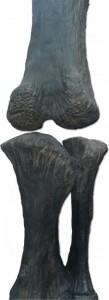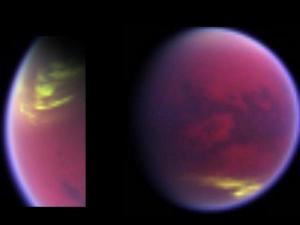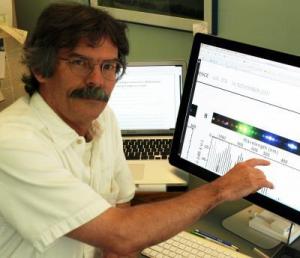Here is a quick roundup of some of the latest science stories in the news during the past couple of days …
Dinosaurs Significantly Taller Than Previously Thought, Research Suggests
 It might seem obvious that a dinosaur’s leg bone connects to the hip bone, but what came between the bones has been less obvious. Now, researchers at the University of Missouri and Ohio University have found that dinosaurs had thick layers of cartilage in their joints, which means they may have been considerably taller than previously thought. The study is being published this week in the journal PLoS ONE (Public Library of Science).
It might seem obvious that a dinosaur’s leg bone connects to the hip bone, but what came between the bones has been less obvious. Now, researchers at the University of Missouri and Ohio University have found that dinosaurs had thick layers of cartilage in their joints, which means they may have been considerably taller than previously thought. The study is being published this week in the journal PLoS ONE (Public Library of Science).
“Our study of the limbs of modern-day relatives of dinosaurs shows that dinosaurs were significantly taller than original estimates,” said Casey Holliday, lead author of the study and an anatomy professor in the MU School of Medicine. “The ends of many dinosaurs’ long bones, which include leg bones such as the femur or tibia, are rounded and rough and lack major articulating structures like condyles, which are bony projections. This indicated that very thick cartilages formed these structures, and therefore the joints themselves, and would have added significant height to certain dinosaurs. This study offers new data into how and why reptiles, and mammals, such as humans, build their joints with such different amounts of bone and cartilage.”
Holliday and Lawrence Witmer, a professor of anatomy at the Ohio University College of Osteopathic Medicine, conducted research on ostriches and alligators, the closest, modern-day relatives of dinosaurs, and then studied the fossilized limbs of different dinosaurs including Tyrannosaurus rex, Allosaurus, Brachiosaurus and Triceratops. The team determined that the lengths of alligators’ and ostriches’ limbs included between 6 and 10 percent cartilage.
Using a “cartilage correction factor,” Holliday determined that many theropod dinosaurs, such as Tyrannosaurus, were only modestly taller whereas ornthischian and sauropod dinosaurs, such as Triceratops and Brachiosaurus, may have been 10 percent taller or more. For example, Brachiosaurus, previously thought to be 42 feet tall, may actually have been more than a foot taller with the additional joint cartilages.
Science Daily: Continue Reading …
Spring on Titan Brings Sunshine and Patchy Clouds
 The northern hemisphere of Saturn’s moon Titan is set for mainly fine spring weather, with polar skies clearing since the equinox in August last year. The visual and infrared mapping spectrometer (VIMS) aboard NASA’s Cassini spacecraft has been monitoring clouds on Titan regularly since the spacecraft entered orbit around Saturn in 2004.
The northern hemisphere of Saturn’s moon Titan is set for mainly fine spring weather, with polar skies clearing since the equinox in August last year. The visual and infrared mapping spectrometer (VIMS) aboard NASA’s Cassini spacecraft has been monitoring clouds on Titan regularly since the spacecraft entered orbit around Saturn in 2004.
Now, a group led by Sébastien Rodriguez, a Cassini VIMS team collaborator based at Université Paris Diderot, France, has analyzed more than 2,000 VIMS images to create the first long-term study of Titan’s weather using observational data that also includes the equinox. Equinox, when the sun shone directly over the equator, occurred in August 2009.
Rodriguez presented the results and new images at the European Planetary Science Congress in Rome on Sept. 22.
Though Titan’s surface is far colder and lacks liquid water, this moon is a kind of “sister world” to Earth because it has a surface covered with organic material and an atmosphere whose chemical composition harkens back to an early Earth. Titan has a hydrological cycle similar to Earth’s, though Titan’s cycle depends on methane and ethane rather than water.
A season on Titan lasts about seven Earth years. Rodriguez and colleagues observed significant atmospheric changes between July 2004 (early summer in Titan’s southern hemisphere) and April 2010 (the very start of northern spring). The images showed that cloud activity has recently decreased near both of Titan’s poles. These regions had been heavily overcast during the late southern summer until 2008, a few months before the equinox.
Science Daily : Continue Reading …
Adult Stem Cells That Do Not Age
 Biomedical researchers at the University at Buffalo have engineered adult stem cells that scientists can grow continuously in culture, a discovery that could speed development of cost-effective treatments for diseases including heart disease, diabetes, immune disorders and neurodegenerative diseases.
Biomedical researchers at the University at Buffalo have engineered adult stem cells that scientists can grow continuously in culture, a discovery that could speed development of cost-effective treatments for diseases including heart disease, diabetes, immune disorders and neurodegenerative diseases.
UB scientists created the new cell lines — named “MSC Universal” — by genetically altering mesenchymal stem cells, which are found in bone marrow and can differentiate into cell types including bone, cartilage, muscle, fat, and beta-pancreatic islet cells.
The researchers say the breakthrough overcomes a frustrating barrier to progress in the field of regenerative medicine: The difficulty of growing adult stem cells for clinical applications.
Because mesenchymal stem cells have a limited life span in laboratory cultures, scientists and doctors who use the cells in research and treatments must continuously obtain fresh samples from bone marrow donors, a process both expensive and time-consuming. In addition, mesenchymal stem cells from different donors can vary in performance.
The cells that UB researchers modified show no signs of aging in culture, but otherwise appear to function as regular mesenchymal stem cells do — including by conferring therapeutic benefits in an animal study of heart disease. Despite their propensity to proliferate in the laboratory, MSC-Universal cells did not form tumors in animal testing.
Science Daily: Continue Reading …
Pulsating Aurorae Secrets Revealed
 The ghostly glows of the northern lights have awestruck generations of sky-watchers. But the inner clockwork behind the most intense displays has remained a mystery—until now.
The ghostly glows of the northern lights have awestruck generations of sky-watchers. But the inner clockwork behind the most intense displays has remained a mystery—until now.
Scientists have found the elusive trigger that sets off the most striking visual outbursts, known as pulsating aurorae or blinking lights around Earth‘s polar regions. (See aurorae pictures.)
Though typical auroras usually stretch more than 620 miles (a thousand kilometers), and last only minutes at a time, pulsating aurora are small glowing patches of light about a 62 miles (a hundred kilometers) wide that flash on and off every 5 to 40 seconds. This flickering gives the appearance of exploding lights in the sky.
“The driver behind auroral pulsation has been a long-standing question in the auroral physics community for more than four decades,” said project leader Toshi Nishimura, a researcher at University of California, Los Angeles.
But Nishimura and colleagues discovered the driving force behind the unusual cosmic fireworks appears to be a particular type of electromagnetic wave that originates in Earth’s protective, bubble-like magnetosphere.
National Geographic: Continue Reading …
Artificial Event Horizon Emits Laboratory Analogue to Theoretical Black Hole Radiation
A laboratory experiment may have offered the first glimpses of a long-predicted quantum effect known as Hawking radiation
Stephen Hawking is famous for many things: provocative best-selling books, Simpsons guest stints and his long and productive life with amyotrophic lateral sclerosis among them. In the field of astrophysics, the University of Cambridge physicist is also known for his work on gravity and black holes, including his 1974 postulation of the eponymous Hawking radiation, a phenomenon by which a black hole should give off a stream of particles from its outer boundary.
Hawking radiation is predicted to arise from quantum fluctuations at the event horizon of a black hole, the point of no return beyond which even light is too slow to escape. Alongside light waves and regular matter falling into a black hole, Hawking realized, ought to be particles that pop into and out of existence. Quantum mechanics dictates that such short-lived particle pairs arise from even empty space, infusing the vacuum with its own ripples of activity. In most corners of the cosmos, those pairs quickly disappear together back into the vacuum, but at the edge of an event horizon one particle may be captured by the black hole, leaving the other free to escape as radiation.
The relatively faint emission has never been detected from a real black hole, so researchers have sought a number of laboratory proxies to demonstrate the general principles of the phenomenon. Now a group of Italian researchers reports what may be the first demonstration of a quantum-mechanical Hawking radiation analogue. In a paper set to be published in Physical Review Letters, the team reports observing photons trickling out from transient event horizons in a piece of glass.
Scientific American: Continue Reading …
Physicists Break Color Barrier for Sending, Receiving Photons
 University of Oregon scientists have invented a method to change the color of single photons in a fiber optic cable. The laser-tweaked feat could be a quantum step forward for transferring and receiving high volumes of secured data for future generations of the Internet.
University of Oregon scientists have invented a method to change the color of single photons in a fiber optic cable. The laser-tweaked feat could be a quantum step forward for transferring and receiving high volumes of secured data for future generations of the Internet.
The proof-of-concept experiment is reported in a paper about work led by UO physicist Michael G. Raymer that appeared in the Aug. 27 issue of Physical Review Letters.
In a separate paper also published by the same journal on Sep. 15, Raymer and collaborators at the University of Bath in the United Kingdom tell how they added hydrogen and a short laser burst to a hollow “photonic crystal” fiber cable to create multiple colors, or wavelengths, of light. This paper, Raymer said, provides groundwork for future research in creating ultra-short light pulses.
The single-photon project, in which a dual-color burst of laser light was used to change the color of a separate single photon of light, is directly applicable to future Internet communications technology, said Raymer, the UO’s Knight Professor of Liberal Arts and Sciences and author of a newly published textbook “The Silicon Web: The Physics Behind the Internet.”
In the computing world, digital data now is contained as individual bits represented by many electrons and is transmitted using pulses of infrared light containing many photons. In quantum computing — a futuristic technology — data might be stored in individual electrons and photons. Such quantum techniques could make data 100-percent secure from hackers and expand the ability to search large databases, Raymer said.
“There is a need for more bandwidth, or data rate, in fiber optic networks,” he said. “In today’s fiber optic lines one frequency of light may carry a phone conversation, while others may carry TV channels or emails, all traveling in separate channels across the Internet. At the level of single photons, we would like to send data in different channels — colors or wavelengths — at the same time. Quantum memories based on electrons emit and absorb visible light — for example, red,” he said. “But the optical fibers we want to use — such as those in the ground now — are optimized to transmit infrared, not visible light.”
Science Daily: Continue Reading …
Alien planets: otherwordly joys
The rocky planet freshly identified in orbit around the star Gliese 581 could indeed be a potential home for life, but nobody should contemplate relocation just yet. At speeds possible with rocket technology, a voyage to Gliese 581, in the constellation Libra, would take about 200,000 years. As a home away from a home, it won’t work. But the planet now known as Gliese 581 g is a reminder of the extraordinary rewards of astronomy.
Cosmological science begins with the Copernican principle that there is nothing special about the solar system. Four centuries after Copernicus, this principle permitted a chain of observation, experiment and deduction that within half a human lifetime confirmed that the universe began with a big bang 13.7bn years ago. Robotic missions to Mars, Venus, Jupiter and Saturn showed that if life could begin on Earth, then it could surely happen on any planet of a similar fabric and mass, orbiting a similar star in a zone not too hot and not too cold for liquid water. Giant telescopes counted the stars: 100bn or more in this galaxy, one of 100bn galaxies. But the solar system appeared to be alone of its kind. The first extra-solar planet – or exoplanet – was identified in 1995: a kind of hot Jupiter, circling close to the star 51 Pegasi 50 light years away. Since then, astronomers have found 490 exoplanets but “seen” none of them.
A planet is a ball of gas and dust dancing in a star’s gravitational embrace. Gravity is a two-way thing and 51 Pegasi b was spotted from flickers of movement in the star that could only be explained by an invisible mass in orbit around it. Since then, researchers have confirmed the existence of exoplanets from rhythmic changes in starlight as an orbiting object moves across the face of the star, but that, too, is hardly a direct sighting. It took 11 years of observation and analysis to demonstrate that at least six planets orbit Gliese 581, and that one of them is a terrestrial-type planet in the so-called Goldilocks zone. Last year a purpose-built planet-spotter began the search for Earth-like planets as they transit across the faces of their parent stars. If there are other habitable planets, could they be inhabited? And if they are not inhabited, then could there be something very special indeed about Earth, and its citizens?
The Gliese 581 team say: “If the local stellar neighbourhood is a representative sample of the galaxy as a whole, our Milky Way could be teeming with potentially habitable planets.” The next step is to devise instruments that can take a closer look, perhaps for distant planetary atmospheres that contain oxygen and methane, the telltale signature of life as we know it. Our Earth-like neighbour 20 light years away is not the climax of a search. It is just a beginning.
Lunar X teams in $20m race to put robot rover on the moon
 Dozens of entrepreneurs and space engineers will gather on the Isle of Man tomorrow to finalise plans for one of the world’s most technologically ambitious and financially lucrative competitions: the Lunar X prize.
Dozens of entrepreneurs and space engineers will gather on the Isle of Man tomorrow to finalise plans for one of the world’s most technologically ambitious and financially lucrative competitions: the Lunar X prize.
The $20m (£12.6m) award, which is being backed by Google, will be given to the first company that builds a robot rover craft, lands it safely on the moon, and directs it on a journey of more than 500 metres. The competition organisers hope to galvanise the exploration of the moon by opening it up to private industry. A deadline of 2012 has been set for all attempts to win the full prize.
“Nasa currently puts the cost of landing a robot rover on the moon at more than $1bn,” said Julian Ranger, the UK financier who is raising cash for Astrobotic, one of the prize’s key competitors. “We believe we can get that cost down to less than $50m, a price tag that will transform lunar exploration and make the moon a target for all sorts of commercial operations.”
The little Astrobotic rover – which resembles a traffic cone on wheels – has also been designed to carry people’s ashes to the moon as well as a variety of small experiments. In addition, it is intended to land the probe near the 1969 landing site of Apollo 11 in the Sea of Tranquillity.
“Part of our business plan will be to get our rover to move round the site and take a 3D high-definition film of it,” said Ranger, a former software developer and self-confessed spaceflight fanatic who raised the initial investment that was needed to set up Astrobotic Technology. “If nothing else, it should prove to the doubters that the Apollo missions really took place.”
The Google Lunar X prize has been created following the success of the Ansari X prize, established in 1996 to inspire private investment in manned space travel. The $10m prize was won by aeronautical engineer Burt Rutan. His SpaceShipOne craft was flown twice within a month to the edge of space in 2004. That technology is now being used to build Richard Branson’s Virgin Galactic fleet of spaceships, which are scheduled to start carrying tourists to space by 2012. Tickets are $200,000 each.